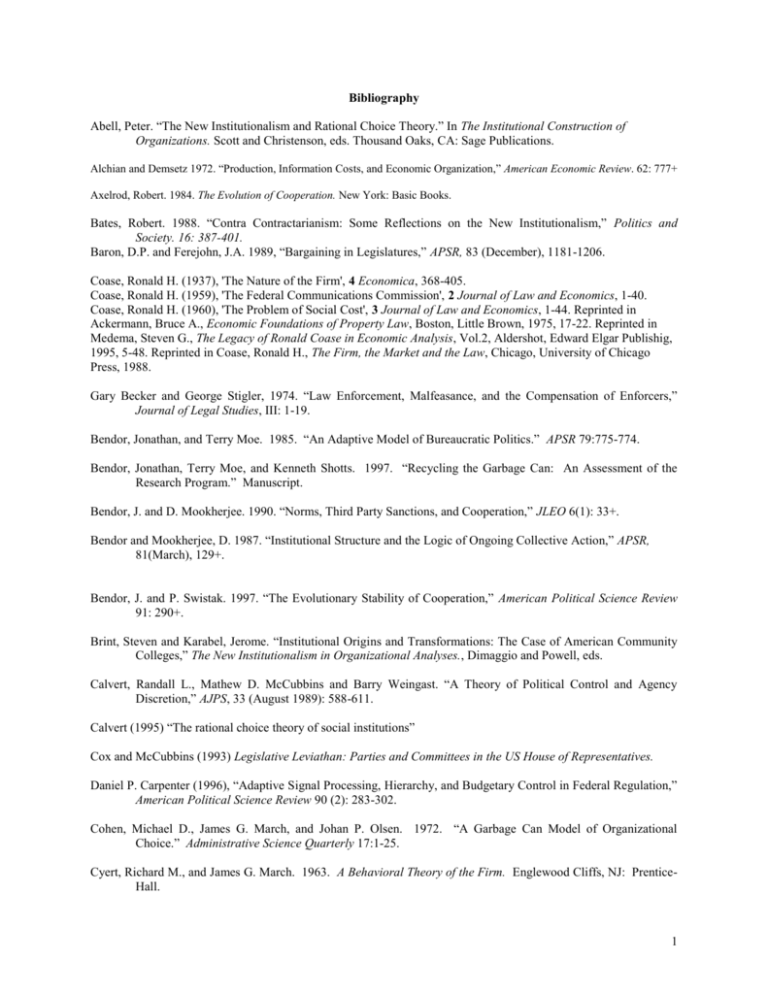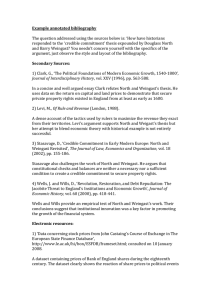Bibliography
advertisement

Bibliography Abell, Peter. “The New Institutionalism and Rational Choice Theory.” In The Institutional Construction of Organizations. Scott and Christenson, eds. Thousand Oaks, CA: Sage Publications. Alchian and Demsetz 1972. “Production, Information Costs, and Economic Organization,” American Economic Review. 62: 777+ Axelrod, Robert. 1984. The Evolution of Cooperation. New York: Basic Books. Bates, Robert. 1988. “Contra Contractarianism: Some Reflections on the New Institutionalism,” Politics and Society. 16: 387-401. Baron, D.P. and Ferejohn, J.A. 1989, “Bargaining in Legislatures,” APSR, 83 (December), 1181-1206. Coase, Ronald H. (1937), 'The Nature of the Firm', 4 Economica, 368-405. Coase, Ronald H. (1959), 'The Federal Communications Commission', 2 Journal of Law and Economics, 1-40. Coase, Ronald H. (1960), 'The Problem of Social Cost', 3 Journal of Law and Economics, 1-44. Reprinted in Ackermann, Bruce A., Economic Foundations of Property Law, Boston, Little Brown, 1975, 17-22. Reprinted in Medema, Steven G., The Legacy of Ronald Coase in Economic Analysis, Vol.2, Aldershot, Edward Elgar Publishig, 1995, 5-48. Reprinted in Coase, Ronald H., The Firm, the Market and the Law, Chicago, University of Chicago Press, 1988. Gary Becker and George Stigler, 1974. “Law Enforcement, Malfeasance, and the Compensation of Enforcers,” Journal of Legal Studies, III: 1-19. Bendor, Jonathan, and Terry Moe. 1985. “An Adaptive Model of Bureaucratic Politics.” APSR 79:775-774. Bendor, Jonathan, Terry Moe, and Kenneth Shotts. 1997. “Recycling the Garbage Can: An Assessment of the Research Program.” Manuscript. Bendor, J. and D. Mookherjee. 1990. “Norms, Third Party Sanctions, and Cooperation,” JLEO 6(1): 33+. Bendor and Mookherjee, D. 1987. “Institutional Structure and the Logic of Ongoing Collective Action,” APSR, 81(March), 129+. Bendor, J. and P. Swistak. 1997. “The Evolutionary Stability of Cooperation,” American Political Science Review 91: 290+. Brint, Steven and Karabel, Jerome. “Institutional Origins and Transformations: The Case of American Community Colleges,” The New Institutionalism in Organizational Analyses., Dimaggio and Powell, eds. Calvert, Randall L., Mathew D. McCubbins and Barry Weingast. “A Theory of Political Control and Agency Discretion,” AJPS, 33 (August 1989): 588-611. Calvert (1995) “The rational choice theory of social institutions” Cox and McCubbins (1993) Legislative Leviathan: Parties and Committees in the US House of Representatives. Daniel P. Carpenter (1996), “Adaptive Signal Processing, Hierarchy, and Budgetary Control in Federal Regulation,” American Political Science Review 90 (2): 283-302. Cohen, Michael D., James G. March, and Johan P. Olsen. 1972. “A Garbage Can Model of Organizational Choice.” Administrative Science Quarterly 17:1-25. Cyert, Richard M., and James G. March. 1963. A Behavioral Theory of the Firm. Englewood Cliffs, NJ: PrenticeHall. 1 DiMaggio, Paul J., and Walter W. Powell. 1983. “The Iron Cage Revisited: Institutional Isomorphism and Collective Rationality in Organizational Fields.” American Sociological Review 48:147-160. DiMaggio, Paul J., and Walter W. Powell. 1991. The New Institutionalism in Organizational Analysis. Chicago: U of Chicago Press. Droback, John. 1997. “Credible Commitment in the United States,” The Frontiers of New Institutional Economics. John Drobak and John Nye, eds. New York: Academic Press. Ferejohn and Shipan. 1990. “Congressional Influence on Bureaucracy,” JLEO s1-s20. Garrett, and Barry R. Weingast. 1993. “Ideas, Interests, and Institutions: Constructing the EC’s Internal Market.” In Goldstein and Keohane, Ideas and Foreign Policy. Gibbons, Robert and Andrew Rutten. 1997. “Hierarchical Dilemmas: Social Order and Self-Interested Rulers,” Working paper, Cornell University. Grossman, Sanford and Oliver Hart. 1986. “The Costs and benefits of ownership,” Journal of Political Economy 94: 691+. Hannan, Michael T., and John Freeman. 1977. “The Population Ecology of Organizations.” American Journal of Sociology 82:929-964. Hannan, Michael T., and John Freeman. 1989. Organizational Ecology. Harvard University Press. Harsanyi, John C., and Reinhart Selten. 1988. A General Theory of Equilibrium Selection. Cambridge: MIT Press. Jensen, Michael. 1983. Organization theory and methodology. Accounting Review 50: 319+. Keohane, Robert. 1984. After Hegemony. Princeton: Princeton University Press. Kingdon, John W. 1984. Agendas, Alternatives, and Public Policies. Boston: Little Brown. Kramer, Gerald. 1986. “Political Science as Science,” in The Science of Politics, ed. Herbert Weisberg. New York: Agathon Press. Krehbiel, Keith. 1998. Pivotal Politics. Chicago: University of Chicago Press. Krehbiel, Keith. 1993. “Where’s the Party?” British Journal of Political Science. 23: 235+. Kreps, David 1990. “Corporate Culture,” in Alt and Shepsle. Kreps, David. 1990. MicroEconomic Theory. Lowery, David, and Virginia Gray. 1995. “The Population Ecology of Gucci Gulch, or the Natural Regulation of Interest Group Numbers in the American States.” AJPS 39:1-29. March, James G., and Johan P. Olsen. 1986. “Garbage Can Models of Decisionmaking in Organizations.” In March and Wessinger-Baylon, Ambiguity and Command. March, James G., and Johan P. Olsen. 1989. Rediscovering Institutions. New York: Free Press. March, James, and Herbert Simon. 1958. “Decisionmaking Theory.” In Grusky and Miller, eds., The Sociology of Organizations (reprint from Organizations). 2 McCubbins, Noll, and Weingast (1989) “Structure and Administrative Process, Politics and Policy.” Virginia Law Review, 75(43):431+ McCubbins and Swartz. 1984. “Congressional Oversight Overlooked: Police Patrols versus Fire Alarms.” AJPS 28: 165+. Merton, Robert. 1940. Bureaucratic Structure and Personality. Social Forces. 18: 560+. Meyer, John, and Brian Rowan. 1977. “Institutionalized Organizations: Formal Structure as Myth and Ceremony.” American Journal of Sociology 83:340-363. Milgrom, Paul, and John Roberts. 1992. Economics, Organization, and Management. New Jersey: Englewood Cliffs. Milgrom, North, and Weingast (1988) “The Law Merchant.” Ec and Pol Moe, Terry M. 1984. “The New Economics of Organization.” AJPS 28:739-777. Moe, Terry M. 1991. “Politics and the Theory of Organization.” Journal of Law, Economics, and Organization 7:106-129. Moe, Terry, and Michael Caldwell 1994. "The Institutional Foundations of Democratic Government: A Comparison of Presidential and Parliamentary Systems." Journal of Institutional and Theoretical Economics 150-151: 171-95. Morrow, Jim. 1994. Game Theory for Political Scientists. Princeton: Princeton University Press. Niskanen, William. 1971. Bureaucracy and Representative Government. Chicago: Aldine. North and Weingast (1989) “Constitutions and Commitment: Evolution of Institutions Governing Public Choice in 17th Century England” Journal of Economic History, XLIX (4) (December): 803. Olsen, Mancur. 1965. The Logic of Collective Action. Ordeshook, Peter. 1986. Game Theory and Political Theory. Cambridge: Cambridge University Press. Parsons, Talcott. 1937. The structure of Social Action. Perrow, Charles. 1986. Complex Organizations. 3rd ed. New York: McGraw-Hill. Pfeffer, Jeffrey, and Gerald R. Salancik. 1978. The External Control of Organizations: A Resource Dependence Perspective. New York: Harper & Row. Pugh, Derek and David Hickson. 1997. Writers on Organizations. Thousand Oaks, CA: Sage Publications. Posen, Barry. 1984. The Sources of Military Doctrine. Ithaca: Cornell University Press. Pratt and Zeckhauser (1985). Riker, William. 1977. “The Future of a Science of Politics,” American Behavioral Scientist. 21(1): 11+. Rose-Ackerman, Susan. 1978. Corruption. New York: Academic Press. Root (1989) “Tying the King’s Hands: Credible Commitments and Royal Fiscal Policy During the Old Regime.” Rationality and Society. 3 Sabatier, P. and J. Loomis, and C. McCarthy. 1995. “Hierarchical Controls, Professional Norms, Local Constituencies, and Budget Maximization,” AJPS 39 (1): 204+. Scott, Richard. 1995. Institutions and Organizations. Thousand Oaks, CA: Sage Publications. Scott, Richard. 1987. Organizations. Prentice Hall Inc. Selznick, Philip. 1949. TVA and the Grass Roots. Berkeley: University of California Press. Shepsle (1991) “Discretion, Institutions, and the Problem of Government Commitment” in Social Theory for a Changing Society. Ed. Pierre Bourdieu and James Coleman. Westview Press. Shleifer, Anrei and Robert Vishny. 1993. “Corruption,” Quarterly Journal of Economics. 108 (3): 599+. Simon, Herbert. 1979. “Rational Decision Making in Business Organizations.” American Economic Review 69:493-513. Barbara Sinclair, "Transformational Leader or Faithful Agent? Principal Agent Theory and House Majority Party Leadership" Legislative Studies Quarterly 24 (August 1999), p. 424. Tolbert, Pamela S., and Lynne G. Zucker. 1983. “Institutional Sources of Change in Organizational Structure: The Diffusion of Civil Service Reform, 1880-1935.” Administrative Science Quarterly 28:22-39. Weingast, Barry. 1979. “A Rational Choice Perspective on Congressional Norms,” APSR 23 (2): 245+ Weingast (1997) “Political Foundations of Democracy and the Rule of Law” APSR. Weingast (1995) “The Economic Role of Political Institutions” Journal of Law Economics and Organization. 11 (1): 1+. Williamson, Oliver E. 1985. The Economic Institutions of Capitalism. New York: Free Press. Williamson, Oliver. 1990. Organization Theory. New York: Oxford University Press. Zucker, Lynne. 1974. “The Role of Institutinalization in Cultural Persistence,” American Sociological Review. 42: 726+. 4







